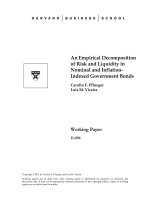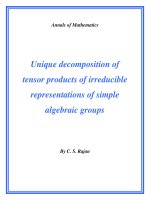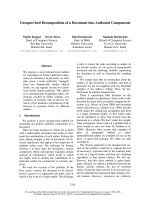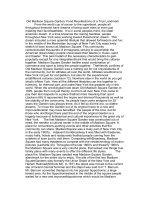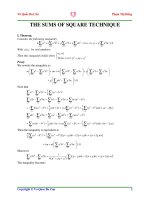IRREDUCIBLE DECOMPOSITION OF SQUARE OF EDGE IDEALS
Bạn đang xem bản rút gọn của tài liệu. Xem và tải ngay bản đầy đủ của tài liệu tại đây (463.01 KB, 5 trang )
<span class='text_page_counter'>(1)</span><div class='page_container' data-page=1>
ISSN: 1859-2171
<i>e-ISSN: 2615-9562 </i> TNU Journal of Science and Technology 203(10): 37 - 41
<i>; Email: </i> 37
<b>IRREDUCIBLE DECOMPOSITION OF SQUARE OF EDGE IDEALS </b>
<b>Nguyen Thi Dung</b>
<i>University of Agriculture and Forestry - TNU</i>
ABSTRACT
<i>Let R = K[x </i>1,...,x <i>d] be the polynomial ring in d variables over K, G = (V(G),E(G)) a graph </i>
<i>associated with variables {x </i>1,...,x <i>d } and IG </i>an edge ideal. In this paper, we describe the structure
<i>of irreducible decompositions of square of edge ideals IG2 </i>of the polynomial ring via corner
elements and coclique sets.
<i><b>Key words: Commutative Algebra; Monomial ideals; Edge ideals; Irreducible decomposition; </b></i>
<i><b>Corrner elements; Coclique sets. </b></i>
<i><b>Received: 12/7/2019; Revised: 16/9/2019; Published: 26/9/2019 </b></i>
<b>PHÂN TÍCH BẤT KHẢ QUY CỦA BÌNH PHƯƠNG IĐÊAN CẠNH </b>
<b>Nguyễn Thị Dung </b>
<i>Trường Đại học Nông Lâm – ĐH Thái Nguyên</i>
TÓM TẮT
<i>Cho R = K[x 1,...,xd] là vành đa thức d biến trên trường K, G = (V(G),E(G)) là đồ thị liên kết với </i>
<i>các biến {x 1,...,xd } và IG là iđêan cạnh. Trong bài báo này, chúng tơi mơ tả cấu trúc của phân tích </i>
<i>bất khả quy của bình phương của iđêan cạnh IG2 của vành đa thức thơng qua các phần tử góc và </i>
các tập coclique.
<i><b>Key words: Đại số giao hoán; Iđêan đơn thức; Iđêan cạnh; Phân tích bất khả quy; Phần tử góc; </b></i>
<i>Tập Coclique. </i>
<i><b>Ngày nhận bài: 12/7/2019; Ngày hoàn thiện: 16/9/2019; Ngày đăng: 26/9/2019 </b></i>
<i>Email: </i>
</div>
<span class='text_page_counter'>(2)</span><div class='page_container' data-page=2>
1. Introduction
Let K be a field, R = K[x1, ..., xd] the
polynomial ring in d variables over K. We
say that an ideal I ⊂ R is irreducible if I
cannot be written as the intersection of two
larger ideals of R. When I is a monomial
ideal, the set Irr(I) of irreducible monomial
ideals appearing in such expression depends
only on I. It is well known that through the
structure of irreducible decompositions of Ik<sub>,</sub>
we can study the asymptotic behavior of the
associated primes, the depth, or the socle of
Ik for k > 2. This problem has been
stud-ied by many authors (see [1] [2], [3], [4], [5],
[6],...) Note that the structure of irreducible
decompositions of Ik, for small values of k,
can also be very complicated even for edge
ideals. In this paper, we are interested in
studying the structure of irreducible
decom-positions of square of edge ideals I<sub>G</sub>k of the
polynomial ring in the case k = 2 via corner
elements and coclique sets.
In the section 2, we will recall some results
about irreducible decompositions, corner
el-ements and coclique sets. In the section 3,
we prove the main resut of the paper which
describles irreducible component of powers of
edge ideals I<sub>G</sub>2 (see Theorem 3.1) and give an
example (see Example 3.2).
2. Preliminaries
In this section, we recall some
terminolo-gies that will be used in the rest of the
pa-per. Let R = K[x1, . . . , xd] be a polynomial
ring with d variables over the field K and
[[R]] the set of all monomials of R. For a
non-zero vector a = (a1, . . . , ad) ∈ Nd, we set
a + 1 = (a1+1, . . . , ad+1) ∈ Nd, ma:= (xaii |
i = 1, . . . , d, ai > 0), xa = xa11. . . x
ad
d and
Supp(a) = Supp(xa) := {xi ∈ V (G) | ai 6=
0}.
Definition 2.1. A non-zero monomial ideal
I of R is called irreducible, if I is of the form
mb <sub>for some non-zero vector b ∈ N</sub>d<sub>.</sub> <sub>An</sub>
ideal I is called m-irreducible monomial ideal
if I is an irreducible ideal and √I = m. An
irreducible decomposition of a monomial ideal
I is an expression of the form I = mb1<sub>∩ . . . ∩</sub>
mbr<sub>, for some non-zero vectors b</sub>
1, . . . , br ∈
Nnand it is irredundant, if none of the ideals
mb1<sub>, ..., m</sub>br <sub>can be dropped from the right</sub>
hand side.
It is well known that if I is a monomial
ideal then I has a unique irredundant
irre-ducible decomposition I = ∩r<sub>i=1</sub>mbi<sub>, the set</sub>
{mb1<sub>, . . . , m</sub>br<sub>} is denoted by Irr(I). We also</sub>
denote by Irrm(I) the set of m-irreducible
monomial ideals which appear in the
irredun-dant irreducible decomposition of I.
Let J ⊂ R be a monomial ideal and µ(J )
the number of minimal generators of J .
Definition 2.2. A monomial z ∈ [[R]] is a
J-corner element if z /∈ J but x<sub>1</sub>z, . . . , xdz ∈ J.
The set of corner elements of J in [[R]] is
denoted by CR(J ).
Note that if rad(J ) = m, then it is well
known that t(R/J ) = card(CR(J )) is the
type of the ring R/J . Now we need some
results from [7].
Theorem 2.3. Let J ⊂ R be a monomial
ideal.
(i) Assume that rad(J ) = m. Let
CR(J ) = {xbj | bj ∈ Nd, j = 1, . . . , t(R/J )}
be the set of corner elements of J . Then
J = ∩t(R/J )<sub>j=1</sub> mbj+1 <sub>is the unique irredundant</sub>
irreducible decomposition of J .
(ii) Assume that rad(J ) 6= m and
J = (xbj <sub>| b</sub>
j∈ Nd, j = 1, . . . , µ(J ))R.
Let m be an integer bigger or equal than any
of the coordinates of the vectors bj. Set J0 :=
J + (xm+1<sub>1</sub> , . . . , xm+1<sub>d</sub> )R and CR(J0) = {xcj |
cj∈ Nd, j = 1, . . . , t(R/J0)} be the set of
cor-ner elements of J0. Then J = ∩t(R/J
</div>
<span class='text_page_counter'>(3)</span><div class='page_container' data-page=3>
is the unique irredundant irreducible
decom-position of J , where ^mcj+1 <sub>is obtained from</sub>
mcj+1 <sub>by deleting all monomials of the type</sub>
xm+1<sub>1</sub> , . . . , xm+1<sub>d</sub> from its generators.
From now on, let G = (V (G), E(G))
be a graph with the vertex set V (G) =
{x<sub>1</sub>, . . . , xd}. Recall that the edge ideal IG
associated to G is the ideal generated by
the edges of G. Note that the edge ideal IG
is a square-free monomial ideal. For each
s 6 d ∈ N, we set S = {x1, . . . , xs} ⊂ V (G)
and Z = V (G) \ S = {z1, . . . , zt}.
Corollary 2.4. Let k, m ∈ N and m ≥ k.
Then the ideal (xa1+1
1 , . . . , xass+1)R belongs to
Irr(I<sub>G</sub>k)R if and only if
(xa1+1
1 , . . . , x
as+1
s , z1m+1, . . . , z
m+1
t )
belongs to Irr(Ik
G+mb), where b = (m+1, m+
1, . . . , m + 1) ∈ Nd<sub>.</sub>
Note that in terms of corner elements,
it is equivalent to say that the monomial
xa1
1 . . . xassz1m. . . ztm is a corner element of
I<sub>G</sub>k + mb. That is
(1) xa1
1 . . . xasszm1 . . . ztm ∈ I/ Gk + mb but
(2) uxa1
1 . . . xassz1m. . . ztm ∈ IGk + mb for
every u ∈ V (G).
It is clear that the second condition is
mediate for u ∈ Z. The first condition
im-plies that for any zi 6= zj ∈ Z, we have
zizj ∈ I/ G.
Definition 2.5. [8] A set C ⊂ V (G) is a
cover of G if for any edge xy ∈ E(G) we
have either x ∈ C or y ∈ C. A set S ⊂ V (G)
is a clique of G if the induced subgraph G[S]
is a complete graph and it is a coclique of G
if the induced subgraph G[S] has no edges.
A coclique set of G is also called
indepen-dent set. The family of cocliques sets of G is
a simplicial complex called independent
com-plex of G and denoted by ∆(G).
For a set S ⊂ V (G) we denote by N (S)
the set of vertices adjacent to some element
in S and ∆S(G) the family of cocliques sets
of G such that N (S) ∩ Z = ∅. Note that S
may be not a subset of N (S) and ∆S(G) is a
simplicial complex.
Remark 2.6. (i) A set C ⊂ V (G) is a cover
of G if and only if V (G) \ C is coclique and C
is a minimal cover of G if and only if V (G)\C
is a maximal coclique.
(ii) A set Z ⊂ V (G) is coclique if and only
if N (Z) ∩ Z = ∅ and Z is maximal coclique
if and only if V (G) = N (Z) ∪ Z.
Example 2.7. (i) The set Z in Corollary 2.4
is a coclique. Indeed, if there is indices i 6=
j such zizj is an edge in G then we would
have xa1
1 . . . xassz1k. . . ztk ∈ IGk + mb, which is
a contradiction.
(ii) As an application of the above result,
let us compute the irreducible decomposition
of IG. Since it is a square free ideal, any ideal
in Irr(IG) is of the type ma for some nonzero
vector a ∈ Nd such that 0 ≤ ai≤ 1 for every
i = 1, . . . , d. Let S = Supp(a), Z = V (G) \
S = {z1, . . . , zt}. Then z1. . . zt is a corner
element of IG+ m(2,2,...,2), which implies that
Z is a coclique. Moreover, it is a maximal
coclique set in V (G), since for every u ∈ S we
have uz1. . . zt∈ IG+m(2,2,...,2), which implies
that there exists some i such that uzi is an
edge in G.
This proves that the irreducible (prime)
ideals in Irr(IG) are of the type ma for some
nonzero vector a ∈ Nd with 0 ≤ ai ≤ 1 such
that V (G) \ Supp(a) is a maximal coclique in
V (G). This also shows that IGis the
Stanley-Reisner ideal associated to ∆(G). Note that
the set Irr(IG) is also the set of minimal
as-sociated primes of I<sub>G</sub>k, for any k ≥ 1.
3. Irreducible components of I2
G
</div>
<span class='text_page_counter'>(4)</span><div class='page_container' data-page=4>
G is a matching that contains the largest
pos-sible number of edges. The matching number
of a graph G, denoted by ν(G), is the number
of edges in a maximum matching of G.
It is well known that if M, N are
mono-mials without common variables and L is a
list of monomials then (M N, L) = (M, L) ∩
(N, L). As a consequence of this fact, every
irreducible component J of I<sub>G</sub>2 can be
writ-ten J = (y1, . . . , yk, x21, . . . , x2l)R, for some
vertices y1, . . . , yk, x1, . . . , xl in V (G). Now
put the sets S := {x1, . . . , xl}, Z = V (G) \
{y1, . . . , yk, x1, . . . , xl} := {z1, . . . , zm}.
Theorem 3.1. Let J be an irreducible
com-ponent of I<sub>G</sub>2 and the sets S, Z as above. Then
we have either
(i) N (S)∩Z = ∅. In this case card(S) = 3,
G[S] is a triangle and Z is a maximal coclique
subset of V (G) \ N (S).
(ii) N (S)∩Z 6= ∅. In this case card(S) = 1
and Z is a maximal coclique subset of V (G).
Proof. Let J = (y1, . . . , yk, x21, . . . , x2l)R be
an irreducible component of I2
G. Then we
have by Corollary 2.4 that J is an
irre-ducible component of I<sub>G</sub>2 if and only if J +
(z3<sub>1</sub>, . . . , z<sub>m</sub>3)R is an irreducible component
of I<sub>G</sub>2 + (y<sub>1</sub>3, . . . , y<sub>k</sub>3, x3<sub>1</sub>, . . . , x3<sub>l</sub>, z3<sub>1</sub>, . . . , z<sub>m</sub>3).
Therefore by term of corner elements we
have x1. . . xlz12. . . zm2 is a corner element of
I<sub>G</sub>2 + (y3<sub>1</sub>, . . . , y3<sub>k</sub>, x<sub>1</sub>3, . . . , x3<sub>l</sub>, z<sub>1</sub>3, . . . , z3<sub>m</sub>)R, i.e.
x1. . . xlz12. . . zm2 ∈ I/ G2+(y13, . . . , yk3, x31, . . . , x3l,
z<sub>1</sub>3, . . . , z<sub>m</sub>3)R(1) and ux1. . . xlz12. . . zm2 ∈
I<sub>G</sub>2 + (y<sub>1</sub>3, . . . , y3<sub>k</sub>, x<sub>1</sub>3, . . . , x3<sub>l</sub>, z3<sub>1</sub>, . . . , z<sub>m</sub>3)R(2)
for every vertex u. We have two following
assertions:
(a) If m ≥ 2 then for every 1 ≤ i < j ≤ m
we have zizj ∈ I/ G.
(b) For every u /∈ Z, the condition (2)
implies that ux1. . . xlz12. . . zm2 ∈ IG2. It
fol-lows that l ≥ 1 and x1. . . xlz12. . . zm2 ∈ IG.
In terms of matching number that means
ν(S ∪ Z) = 1 and ν(S) ≤ 1. Now we prove
the theorem.
(i) If N (S) ∩ Z = ∅ then since
x1. . . xlz12. . . zm2 ∈ IG and the assertion (a),
we have x1. . . xl ∈ IG, i.e. ν(S) = 1.
For u = x1, we have x1x1. . . xlz21. . . z2m ∈
I<sub>G</sub>2. But since N (S) ∩ Z = ∅, we have
x1x1. . . xl ∈ IG2. Then there exist two edges
xi1xi2, xi3xi4 ∈ IGand they must have a
com-mon vertex, otherwise x1. . . xl ∈ IG2, a
con-tradiction. Hence there exists i1, i2 such that
x1xi1, x1xi2 ∈ IG.
Suppose that l ≥ 4. Let xi3 distinct
from x1, xi1, xi2. By using the same
argu-ment as the above, then there exists i4, i5
such that xi3xi4, xi3xi5 ∈ IG. We have
ei-ther xi4 6= x1 or xi5 6= x1. Suppose xi4 6= x1
and if xi4 = xi1 then x1xi2, xi1xi3 implies
ν(S) > 1, a contradiction to (b), if xi4 = xi2
then x1xi2, xi2xi3 also implies ν(S) > 1, a
contradiction to (b). By similar argument for
the case xi5 6= x1 and xi5 = xi1 or xi5 = xi2.
So l = 3.
Moreover, since xi1x1xi1xi2z
2
1. . . zm2 ∈ IG2,
it implies xi1x1xi1xi2 ∈ I
2
G, and consequently
xi1xi2 ∈ IG. Hence S is a triangle.
Finally, let u be a vertex such that Z ∪
{u} is coclique then ux1. . . xlz12. . . zm2 ∈ IG2,
implies u ∈ N (S), this proves the maximality
of Z inside V (G) \ N (S).
(ii) Assume that N (S) ∩ Z 6= ∅. Let z1 ∈
N (S) ∩ Z and suppose that x1z1 ∈ IG. Then
we have the following claims:
(1) x2. . . xl6∈ IG.
(2) N (S) ∩ Z 6= x1. Indeed, if there exists
i 6= 1 such that x1z1, xizj are two edges then
x1. . . xlz12. . . zm2 ∈ IG2, a contradiction.
(3) S has only one element. Indeed,
if there exists u ∈ S such that u 6=
x1 then by (2) we have u ∈/ N (Z).
Since ux1. . . xlz12. . . zm2 ∈ IG2, there
ex-ists v ∈ S such that uv ∈ IG and
x1. . .bv . . . xlz
2
1. . . zm2 ∈ IG. If v 6= x1
then uvx1z1 ∈ IG2, which implies that
</div>
<span class='text_page_counter'>(5)</span><div class='page_container' data-page=5>
v = x1 then we have x2. . . xlz12. . . zm2 ∈ IG,
a contradiction to (1). Thus card(S) = 1.
(4) Let u /∈ Z, we have ux<sub>1</sub>z<sub>1</sub>2. . . z<sub>m</sub>2 ∈ I2
G+
(y<sub>1</sub>3, . . . , y3<sub>k</sub>, x<sub>1</sub>3, z<sub>1</sub>3, . . . , z3<sub>m</sub>). Clearly, u must
belong to N (Z), otherwise ux1z12. . . zm2 ∈/
I<sub>G</sub>2 + (y<sub>1</sub>3, . . . , y3<sub>k</sub>, x3<sub>1</sub>, z<sub>1</sub>3, . . . , z3<sub>m</sub>), a
contradic-tion. Hence Z is maximal coclique subset of
V (G).
Example 3.2. In the figure 1 we have a
graph G with ν(G) = 4. We have twenty
two maximal cocliques sets
{a, d, h, j, k}, {a, d, g, i}, {b, d, h, j, k},
{b, d, g, i}, {c, d, h, j, k}, {c, d, i},
{a, e, h, j, k}, {a, e, g, i}, {b, e, h, j, k},
{b, e, g, i}, {c, e, h, j, k}, {c, e, i}, {a, f, h, j, k},
{a, f, i}, {b, f, h, j, k}, {b, f, i}, {c, f, h, j, k},
{c, f, i}, {a, d, g, j, k}, {b, d, g, j, k},
{a, e, g, j, k}, {b, e, g, j, k}.
Figure 1
Hence IG has 22 irreducible components.
In this example, we have two triangles F1 =
{a, b, c}, F<sub>2</sub> = {d, e, f }. Consider for
ex-ample the set F1, there are exactly six
co-clique sets Z ⊂ V (G) \ N (F1) that are
maximal subset of V (G) \ N (F1). Namely,
Z1 = {d, h, j, k}, Z2 = {e, h, j, k}, Z3 =
{f, h, j, k}, Z4 = {d, i}, Z5 = {e, i}, Z6 =
{f, i}. This shows that
(a2, b2, c2, e, f, g, i), (a2, b2, c2, d, f, g, i),
(a2, b2, c2, d, e, g, i), (a2, b2, c2, e, f, g, h, j, k),
(a2, b2, c2, d, f, g, h, j, k), (a2, b2, c2, d, e, g, h, j, k)
are embedded irreducible components of I2
G.
Similarly, for F2there are also exactly six
co-clique sets. As a consequence there are
ex-actly 12 embedded irreducible components of
I<sub>G</sub>2. We can describe them completely.
References
[1] M. Brodmann, ”Asymptotic Stability of
Ass(M/In<sub>M )”, Pro. Amer. Math. Soc., 74, pp.</sub>
16-18, 1979.
[2] J. Chen, S. Morey and A. Sung, ”The stable set
of associated primes of the ideal of a graph”,
Rocky Mountain J. Math, 32, pp. 71-89, 2002.
[3] H. T. Ha and S. Morey, ”Embeded associated
primes of powers of squarefree monomial ideals”,
J. Pure Appl. Algebra, 214, pp. 301-308, 2010.
[4] J. Herzog and T. Hibi, ”Bounding the socles of
powers of squarefree monomial ideals”, MSRI
Book Series, 68, pp. 223-229, 2015.
[5] J. Martinez-Bernal, S. Morey and R. Villarreal,
”Associated primes of powers of edge ideals”,
Collect. Math. , 63, pp. 361-374, 2012.
[6] N.Terai and N. V. Trung, ”On the associated
primes and the depth of the second power of
squarefree monomial ideals”, J. Pure Appl.
Al-gebra, 218, pp. 1117-1129, 2014.
[7] W. F. Moore, M. Rogers and S.
Sather-Wagstaff, Monomial ideals and their
decompo-sitions, Springer International Publishing, 2018.
[8] E. Miller and B. Sturmfels, ”Combinatorical
commutative algebra”, Graduate Texts in
Math-ematics, 227 Springer-Verlag. New York, pp.
xiv+417, 2005.
[9] L. Lov´asz and M. D. Plummer, Matching
</div>
<!--links-->

